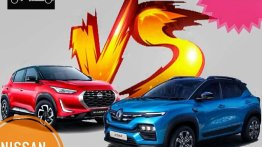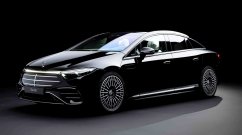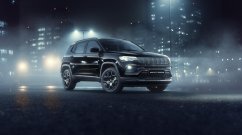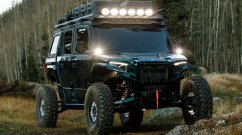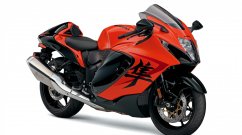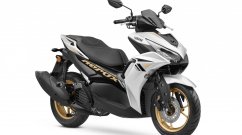Renault's V6 dCi Diesel engine Image Gallery
Renault Press Release:
Introduction
The Renault-Nissan Alliance unveiled its brand-new V6 dCi Diesel engine (V9X type) on Laguna Coupe at the Paris motorshow, in October 2008. This engine is the first Diesel V6 engine developed and produced by the Alliance. It will equip upper-range vehicles to meet the growing worldwide demand for engines that are powerful and yet fuel and CO2 efficient.
The Alliance cooperation has made it possible for both Renault and Nissan to offer a state-of-the art premium powertrain to their customers, all around the world.
The new V6 dCi: a Renault-Nissan Alliance-led project
The Renault-Nissan Alliance, which will celebrate its 10th anniversary in 2009 is a successful unique example of two companies that share common values, i.e., trust and mutual respect, but keep their own corporate identity. The Alliance is always pursuing opportunities of synergies within the two groups, through a common purchasing organization, RNPO (Renault-Nissan Purchasing Organization), co-developed projects, like Koleos, and manufacturing collaboration, through the sharing of best practices. The new V6 dCi is an example of what the Alliance is all about: the engine was developed by the two companies, has been assembled in a Renault plant and will be fitted in Renault, Nissan and Inifiniti vehicles.
This practice makes it possible to share the entry ticket, to make economies of scale, and to offer more vehicle variants to customers.
An engine whose existence has been made possible thanks to the existence of the Alliance
It would not have been relevant for either Renault or Nissan to produce this powertrain on their own, as volumes would have been too low to make it profitable. Associating the two companies has both favored economies of scale and created higher output.
The Renault-Nissan collaboration has reduced R&D expenditure and less industrial investment, as engineering and industrial were split.
An engine co-developed by Renault and Nissan
The new engine’s specifications were established to meet the expectations of Renault’s Nissan’s and Infiniti’s customers, which means that the engine can be put on various types of cars (coupes, sedans, SUVs…) and commercialized in various parts of the world, such as Europe, and the US. This is why it has been decided to use a V architecture. V engines can be fitted either longitudinally, as it is often the case in Nissan/Infiniti vehicles or transversally, like in a Laguna.
The engine was developed mainly in Rueil-Malmaison, near Paris, a town that hosts Renault’s powertrain engineering center. The new V6 dCi engine derives from other Renault engines, such as the 2.0 dCi, and thus, benefited from the know-how acquired during this 4-cylinder engine development. As the upper parts of the V6 dCi are very similar to these of the 2.0 dCi, the conception of the new engine was faster, and cheaper.
Using existing technologies also guarantees better quality, which is a priority for Renault, as the company’s commitment is to put Laguna among the top 3 vehicles of its segment in terms of product and service quality.
Nissan engineers have been fully involved in the engine development, and share their competencies, to make it sure that the engine will fully adapt to Nissan’s vehicles.
An engine that will be fitted on Renault Group and Nissan Motors Company upper range vehicles
Concerning Renault, it is already available on Laguna Coupe, and will soon be offered on Laguna Sedan and Laguna Estate, in early 2009.
Concerning Nissan, it will be available on the new version of Maxima in the US and on Pathfinder and Navarra, in Europe. It will also be available on Infiniti EX, FX and M models, in Europe.
This Diesel engine will also equip other vehicles in the future, as the new V6 dCi has been conceived for use in various types of vehicles such as coupes, sedans, station wagons, SUVs or pick-up trucks. It is also possible to adapt it to various environmental regulations, such as the Euro5 or the Californian regulations.
Renault needs a new Diesel V6 engine to accompany its new and future upper range vehicles such as Laguna Coupe, while Nissan will use it to accompany the development of Infiniti in Europe and to offer alternatives to hybrid or gas engine in the Northern hemisphere.
The new engine will help the two companies reach these goals.
An engine intended to meet a growing commercial demand for powerful Diesel Powertrains
Diesel engines are already popular, mainly in Europe, while demand is growing in the rest of the world. In France, for example, 75 % of first hand vehicles are already equipped with Diesel engines (source: CCFA). Demand for Diesel engines has been higher than expected in Japan. Nissan X-Trail has been available there with the Renault-Nissan Alliance’s 2.0 dCi engine since September 2008. In only two weeks of commercialization, this engine reached its 10-month sales objective, demonstrating the potential of such engines on the Japanese market. The US has also opened its doors to Diesels, as many premium carmakers already propose such engines, in a context of high fuel prices. Both Renault and Nissan need to produce vehicles equipped with Diesel engines to address this demand, which is already huge in Europe, and likely to rise in the rest of the world. The popularity of Diesel engines can be explained by the fact that these engines offer a high level of efficiency: they deliver more torque and as much power as their gas counterparts that post the same displacement, while also consuming less fuel, and emitting less CO2.
Gas engines remain popular among passionate drivers, who seek racetrack performances, i.e., a lot of power at a high level of revolutions per minute. The new dCi 235 engine, contrary to most Diesels, is nevertheless able to attain 5000 rpm, which makes it a serious competitor to gas engines in terms of driving pleasure. Gas engines are also said to sound better and to vibrate less than Diesel ones. Renault and Nissan have worked on bettering the sound of the new V6 dCi and reducing the level of vibrations.
A premium performance-oriented engine fully adapted to the needs of upper range vehicle buyers
Renault’s Diesel engines, known as dCi, such as the 1.5 dCi (K9K type) the 1.9 dCi (F9Q type) or the 2.0 dCi (M9R type), are praised for their performances, fuel and CO2 efficiency, silence, and lack of vibrations. They are perfect for everyday driving, as they are environmentally friendly, reliable and durable, as well as dynamic.
Nissan’s V6 engines are references on their segment. Each year, Nissan produces more than a million V6 engines, making Nissan the biggest V6 producer in the world. The 3.5L gas motor fitted on vehicles such as the 350Z has won many prizes. Nissan’s V6 have been ranked among Ward’s Ten best engines of the world for 14 years. Nissan’s new twin turbo 3.8l V6 fitted on Nissan GT-R is one of the world’s most performance-oriented powertrain, as it has outperformed most sportscars on the Nürburgring racetrack, with an astonishing 7’29” laptime.
The new V6 Diesel engine is a technological high displacement multi-valve V powertrain, which means it offers a high level of performance and driving pleasure. The new powertrain has the highest level of torque in the Renault lineup with 450nm. It therefore allows very fast accelarations either from 0 to 100km/h (7”30 on Laguna Coupe dCi 235) or from 80 to 120km/h (6”10 on the same vehicle). Additionally, on Laguna Coupe, the new Diesel V6 posts 235hp, which makes it Renault’s second most powerful engine offer, after the 3.5l gas engine (245hp). Further versions of this engine will be commercialized with more power and more torque, as it can generate up to 265hp and 550nm when put longitudinally on a car.
An environmentally friendly state-of-the-art engine in line with the customers’ new Expectations
The new V6 dCi engine derives from the 4-cylinder in-line 2.0 dCi launched in 2005. They share components, but the combustion chamber design has been optimized to improve the trade-off between emission levels and fuel efficiency. On Laguna Coupe dCi 235, it emits 192g of CO2 per kilometer, which is in line with most of the best German engine makers. Of course, the new V6 will be fitted with particle filters and a SCR, to make it one of the cleanest Diesel engines in the world. Very low noise levels are the result of a joint optimization of powertrain engine base, injection and tuning strategies.
Engineers also took recycling issues into consideration, as 95% of the engine is reusable and it is also produced in an ISO 14001 plant.
An engine produced by Renault in Cleon, France
The new 3.0L dCi 235 V6 engine will be produced at the Cleon plant, 80 miles west of Paris. This plant, which celebrates its 50th birthday in 2008, produces the upper range gas and Diesel engines of the Renault group, i.e.:
- the 1.9 dCi Diesel engine (F9Q type), fitted on Megane
- the 2.0 gas engine (F4RT), fitted on Clio, Megane, Laguna
- the 2.0 turbo gas engine (F4RT) fitted on Megane RS, Laguna, Espace and Vel Satis
- the 2.0 Diesel engine (M9R type) fitted on Megane, Laguna, Espace and Vel Satis
- the 2.2 and 2.5 Diesel engine (G9T and G9U type) fitted on Master
In average, Renault-Cleon produces about 1/3 of Renault’s engines and sells part of its production to Nissan and Suzuki. Cleon also produces 5 and 6 speed gearboxes.
Cleon was first and foremost chosen by the Alliance to produce the new engine because it favors economies of scale. The new V6 dCi derives from the 2.0 dCi, which is also produced at Cleon. Producing the two engines in the same plant makes it possible to reduce logistics costs and to benefit from a volume effect.
The Cleon plant has a great know-how in terms of high displacement complex engines. Producing the new figurehead of the dCi line-up in a plant that masters the production of high power powertrains was thus the obvious choice.
Cleon is also well located, from a logistics point of view, since it is closed to the Sandouville plant, where Laguna is produced, and half way between the US, where the Maxima will be produced, and Japan, where Infinitis are made.
Additional information:
- The engine characteristics of Laguna Coupe dCi 235
Engine name: 3.0 V6 dCi 235 (V9X)
Emission regulation: Euro IV ; Euro V compatible
Particle filter: FAP
Number of cylinders/valves: 6/24
Injection type: Diesel direct injection, 1600 bar double common rail, 7 hole Piezo injectors
Balance shaft : no
Crankcase/cylinder head material: Cast iron/Aluminium
Displacement: 2993cm3
Bore X stroke: 84mm X 90mm
Compression ratio: 16:1
Maximum power: 173kw/3750rpm (235ch)
Maximum torque: 450nm/1500rpm
Performances:
0-100km/h: 7”30
400m standing start: 15”30
1 000m standing start: 27”70
Top speed: 242km/h
80 to 120km/h acceleration in D: 6”10
Fuel consumption and CO2 emissions
Urban cycle: 10.6l/100
Extra urban cycle: 5.7l/100
Combined cycle: 7.2l/100
CO2 emissions: 192g/km


